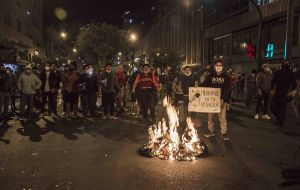MercoPress. South Atlantic News Agency
Night of fury in Peru
 Demostrators showed their outrage at what they consider an illegitimate government. Photo: Nicolás Monteverde
Demostrators showed their outrage at what they consider an illegitimate government. Photo: Nicolás Monteverde  The fire was frequently started by more experimented protestors, to be used as defending walls from the police at the streets. Photo: Nicolás Monteverde
The fire was frequently started by more experimented protestors, to be used as defending walls from the police at the streets. Photo: Nicolás Monteverde By Nicolás Monteverde
LIMA, Peru – With music, dance, and chants, several groups of protesters expressed their outrage against the president Martín Vizcarra's Impeachment on Monday in Lima. The mobilization started at 9 am in Plaza San Martín, the iconic park in the heart of Lima where protests often take place first.
With phrases like “[Manuel] Merino is not my president” the demonstrations were clear about the people’s outrage against the absurd political situation that the Peruvian Congress made by ousting Vizcarra.
But, beyond looking for an impossible return of Vizcarra to the presidency of Peru, demonstrators looked more like in the will to express how angry the Peruvian people feel at the current situation.
The protests, initially pacific, escalated in tensions with police when protesters tried to get into the Plaza de Armas, where Govern Palace and Republic's Congress are located. The plaza was strongly guarded by different police forces.
Far from last year's Chilean uprising, protesters were not very organized, but more spontaneous. There weren't different confrontation lines either self-defence groups to avoid the repression.
Most of the persons who show their beliefs at the streets were young men and women, probably students, who believe not only that this isn’t a legitimate government, but also they don’t own the state obedience now.
“Article 46.- Usurper Government. Insurgency right.
No one owes obedience to a usurping government, nor to those who assume public functions in violation of the Constitution and the laws.”
Not in vain, that quote from the Peruvian constitution was visible in different paints around the city walls, and on the posters of the protesters.
Before noon, the tensions finally evolved to clashes between a part of the protestors and the police. There were shots, tear gas, and stick strikes by the officers, meanwhile, the protesters answered with a rain of rocks against police barricades.
From this point, every hour meant more clashes, and each clash was harder than the previous one. The police, unusually, bombed with tear gas the famous Plaza San Martín since there they tried to keep this park empty of demonstrators.
Unluckily for the order forces, more people joined the riots as the sun set on the horizon, so new groups of spontaneous rioters were trying to take the Plaza.
So as Police Departement was trying to clear the park, other groups continued, divided groups re-grouped in nearby streets and continued their struggle in the will of making new problems for the unpopular new president, Manuel Merino.
In the evening, the protests intensified as assistants denounced violent police abuse against divided protestors groups.
The fire was frequently started by more experimented protestors, to be used as defending walls from the police at the streets. Stones were also a frequent response from the people.
Due to the pandemic, the daily curfew applies at 11 pm in Peru every day. From this hour, every person without official permission can be detained and fined in the street.
Around 9:30 pm, the steady stream of new protesters finally stopped. From this point, the police could divide more quickly, and organize better.
The last groups started to get away from the historic centre of Lima around 10:00 pm. Tired and bombed, the mass that protested on Monday was composed by a lot of young men and women who never protested before, which means they’re new not only to manage police repression but that they could strike better the next days in case the protest continues as strong as today.
That’s how the first day of Merino’s presidency was held. With the capital city historic centre on fire, and most of the cities mobilized against his government. We’ll see how long this government can last.




Top Comments
Disclaimer & comment rulesCommenting for this story is now closed.
If you have a Facebook account, become a fan and comment on our Facebook Page!